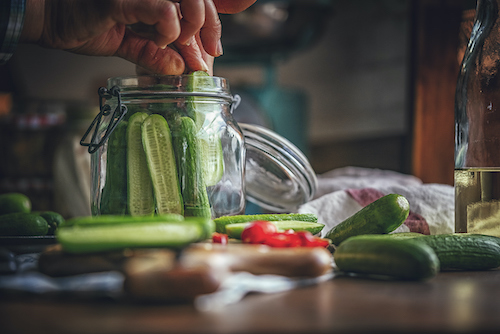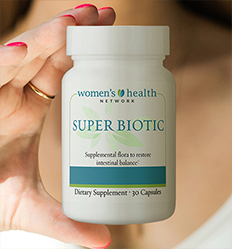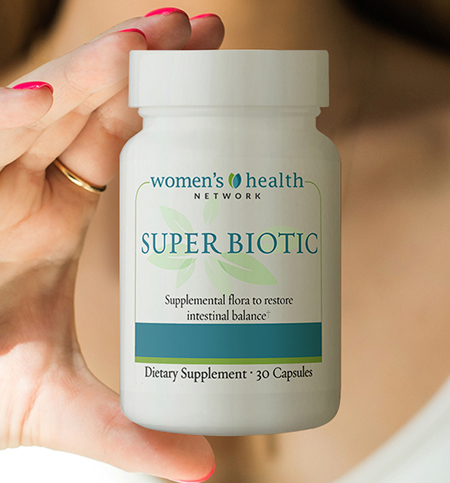Authored by Dr. Susan E. Brown, PhD
Eating pickles can be an easy way to get the benefits of probiotics. But not all pickles are created equal. Many of the pickles you find on store shelves are packed with ingredients you don’t want. That’s why it’s important to know which pickle to buy and which to avoid — because the pickle you buy really matters.

For example, many of the pickles on store shelves have ingredients like alum, which is an aluminum salt that is intended to keep the pickles firm. Even small amounts of alum can add up to toxicity over time. Some pickles also include chemical preservatives, which are completely unnecessary — the pickling process has already preserved the pickle! Once you know what to look for, you’ll not only find pickles that are tasty, but healthy too. Like other fermented foods, pickles can be a terrific add-on to a healthy diet.
Picking the picture perfect pickle
#1. Look for brands with only a few ingredients on the label. The ideal pickle would be made with pure water, sea salt and organic cucumbers plus flavorful ingredients like dill, mustard seeds, garlic, peppercorns, and other herbs and spices. That’s all you should see on the label. This combination encourages true fermentation by native Lactobacillus species — an important probiotic bacterium that promotes gut health. Most brands go far beyond that simple combination in the name of uniform products or meeting customer expectations for a sweeter or more acidic product. So it’s important to read labels carefully.
#2. Avoid pickles with added sugar. Fermentation is what happens when Lactobacillus bacteria convert sugars and starches into lactic acid. These sugars and starches are already plentiful in the kinds of vegetables used for store-bought pickles. Added sugars are not needed and don’t improve either the pickle or your overall diet. So leave them out! When choosing pickle types, look for dill, Kosher dill, sour and half-sour as your best bets for leaving out sugar. But read labels carefully! Bread and butter pickles and sweet pickles will contain sugar — often quite a bit. Skip these types. Prefer your pickles in relish form? The same rules apply. Look for dill pickle relish as your best bet for no added sugar. Sweet relish? Like the name implies, sugar is a prime ingredient.
#3. Leave out the vinegar, too — if you can. You may be surprised to hear that vinegar doesn’t make the pickle more nutritious and wholesome. Even if it’s organic apple cider vinegar, which is otherwise beneficial. The problem is that the acidity of the vinegar suppresses all those beneficial bacteria. So what you’re really getting is vinegar-enhanced cucumber spears rather than a fermented product that promotes greater diversity in your gut flora. If you simply can’t find a no-vinegar pickle, choose brands where vinegar is further down in the ingredients list on the label. The further down you find it, the less of it there is.
#4. Look for brands that advertise their products as “fermented” or “raw.” Those words mean they’re made via the traditional fermentation processes and are not pasteurized (heat treated). This allows the Lactobacillus bacteria to flourish.
Try Dr. Brown’s homemade pickles
One way to ensure that your pickles are packed with probiotics? Make your own with this easy recipe.
Fermented Dill Pickles
adapted from Cultures for Health
Ingredients
2 Tbsp sea salt
1 quart filtered water
2-3 bay leaves
2-3 cloves garlic, peeled and lightly crushed
2 large heads of fresh dill or 2 tsp of dill seed
1-3 tsp of pickling spice (depending on desired flavor)
Enough pickling cucumbers to fill a quart-sized jar
Instructions
1. Make a brine by stirring sea salt and water together until the salt is dissolved.
2. Clean cucumbers and slice lengthwise into spears.
3. In a clean quart-sized mason jar, add 2 bay leaves, 2 cloves of garlic, one head of dill or 1 tsp of dill and 1 tsp of pickling spice.
4. Pack the cucumbers tightly on top of the spices.
5. Cover the cucumbers with a layer of the remaining bay leaves, dill, garlic and spices.
6. Pour the brine over the pickles, leaving an inch of headspace in the jar. (You will have brine left over.)
7. Place the lid on the jar. Do not screw on tightly to avoid pressure build up.
8. Store the jar in a cupboard at room temperature (around 70°F is preferred).
9. Check daily. The brine turning cloudy and bubbly indicates that fermentation is taking place.
10. After 2-3 days, sample a pickle for taste and texture; add more spices if desired. Pickles may take up to 6 days to ferment fully.
Once the desired taste and texture is reached, eat your fermented pickles right away or store in the refrigerator for up to two months.
 | Build a better gut! Learn how to rebalance your gut flora to reduce troubling digestive symptoms. |









